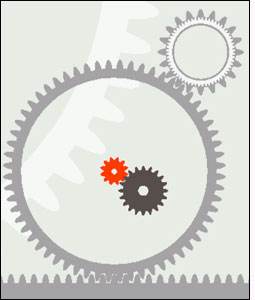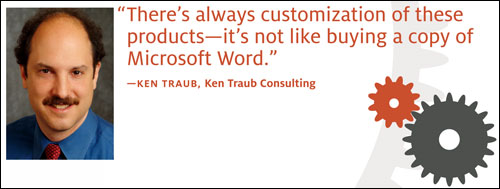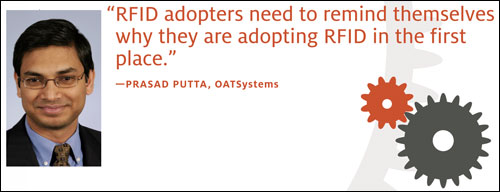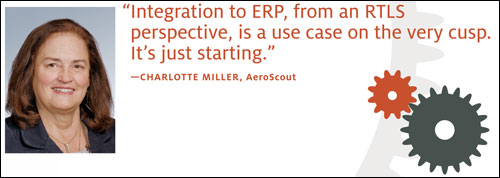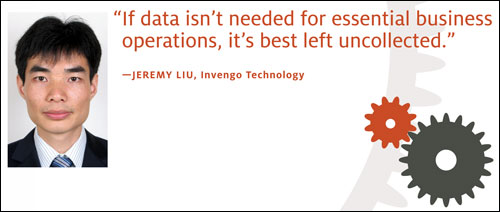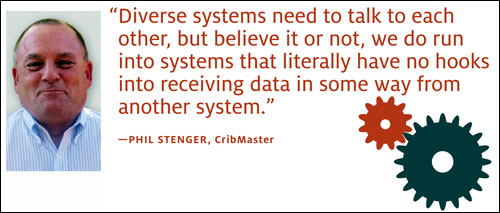Feb 01, 2012Getting a radio frequency identification system to gather lots of data isn't particularly hard. The real challenge arises when it's time to put that collected information to work.
Integrating RFID-generated data into business applications so that essential information can be viewed, analyzed, applied and presented to end users is often far more difficult than assembling the data. Since RFID is used in diverse ways by a wide variety of organizations and with many different applications, it's impossible to create a single, all-purpose RFID data-integration strategy. This leads many businesses to develop unique integration concepts and tools, or to adopt an amalgamation of approaches used by other organizations.
Sometimes, an adopter is fortunate, and fit-like-a-glove data integration is achieved on time and within budget. Too often, however, businesses find themselves coping with a system that resembles the lead character in a science-fiction movie: a creature both weird and dysfunctional. Even worse, the overdue and over-budget creation runs about as well as a 1972 Ford Gran Torino with a Subaru three-cylinder engine.
Data integration poses a significant challenge for a broad range of RFID adopters in almost all business sectors, says Ken Traub, president of Ken Traub Consulting, a Lexington, Mass., company that works with businesses that rely on advanced software technology. The target applications, however, are generally predictable. "The systems that come up over and over again are enterprise resource planning [ERP] systems, warehouse-management systems and, for manufacturers, their manufacturing-execution systems," he says. Yet, enterprise customers tend to use particular products in different ways—a big reason vendors have so much trouble producing RFID-compatible applications that work directly out of the box. "Everybody has a slightly different picking process in their warehouse, everybody has a different layout to their factory floor and all that," Traub says. "There's always customization of these products—it's not like buying a copy of Microsoft Word."
Despite the serious challenges posed by data integration, it's possible for any business, regardless of its size or mission, to get its RFID data to mesh seamlessly with both current and planned applications. Here are seven steps that lead to data integration success.
To achieve data integration without any painful surprises, it's important to have a thorough understanding of RFID technologies and practices. Whether you're a business or IT manager, the more you know about RFID, the better prepared you'll be to discuss your dataintegration needs and preferences with software vendors, systems integrators and other project partners.
Phil Stenger, a software solutions consultant at CribMaster, an inventory-management system developer, in Marietta, Ga., is surprised by some of the assumptions RFID newcomers make. Many, for instance, innocently believe data integration occurs more or less automatically. "There's this layman's attitude that everything done in one system will somehow magically occur in another," he says.
While brushing up on RFID basics, it's important to pay particular attention to the systems and practices that relate to your industry. Data integration means different things to different businesses, says Prasad Putta, executive VP and general manager for merchandise visibility and RFID at OATSystems, an RFID systems developer in Waltham, Mass. Even individual departments within a company may have unique data-integration needs. "In retail, integration is often focused on the perpetual inventory-management system and also with the point-of-sale system," he says. "Similarly, integration with existing loss-prevention systems can provide an additional level of insight into potential theft events at the point of exit— what was stolen, how much and more."
Since few IT managers, and fewer business managers, fully understand the nuances of integrating various types of RFID data with different kinds of applications, finding specific solutions to data-integration challenges usually means seeking advice from someone who understands the adopter's field, such as an RFID or application vendor representative or a systems integrator. In fact, it's usually best to seek insight from multiple experts.
Stenger, who has helped many businesses solve their RFID integration problems, says he begins by listening to what the client has to say. "A lot of times, I start with [the client's] expectations," he explains. "I seek to discover what data is pertinent to be brought into our system or another system." From that point, it's mostly a matter of determining the right integration approach based on the customer's goals and technologies. Like other data-integration experts, Stenger has an array of middleware tools at his disposal. "There are a lot of different methods, and we've written our own proprietary export [software], which gives us the ability to do XML, EDI—almost any imaginable format from Web service posts to FTP, SFTP... transport methods."
Many companies turn to RFID to solve a specific business challenge. But while creating a first RFID system, it's also important to be mindful of how the technology might be used to improve other business processes.
By failing to understand that their initial RFID deployment may eventually form the basis of a larger system covering many different activities, new adopters risk inviting future integration headaches. In fact, integration practices learned while creating an initial RFID system can be easily applied to future deployments. Traub suggests that businesses planning their first RFID investment set aside some time to consider the company's overall data gathering and organization strategy.
"Companies will really benefit by taking more of an enterprise architecture view and laying a foundation for using visibility data within their enterprises," Traub says. "That will allow them to build [out] from their first project, increase their use of RFID over time and also increase the different ways they can use that data for business benefits within their organization."
As the data-organization strategy is being developed, it's essential to place business needs first and then worry about how the information will interface with applications. "The key thing is to establish an architecture for what you're doing, and to establish that in a way that is independent from vendor offerings, so you really figure out what's right for your business," Traub says.
"RFID adopters need to remind themselves why they are adopting RFID in the first place," OATSystems' Putta says. "Start with a specific business process that needs real-time visibility, and then take a business-focused approach to implementing an integration solution that meets those specific needs. I know that sounds overly simple, but you would be surprised how often it is forgotten."
RFID deployments straddle the worlds of IT and business, so it makes sense to involve representatives from both teams in the integration planning process. "On a typical interface project, it has to have business executives included," CribMaster's Stenger says. "It can't just be a bunch of IT folks sitting around deciding how they're going to send the data back and forth, because it's really pertinent to understand what the business processes are."
IT people often focus on technical issues at the risk of losing sight of the big picture. "It's not really hard to translate the data, but somebody has to understand what the ones and zeros coming from an RFID reader mean, and how to translate that data into something that meets business needs," says Mike Beedles, director of the integration solutions division of SATO America, a label printer vendor in Charlotte, N.C. "So having some people with experience in both [fields], if it's an RFID project, is highly, highly recommended."
STRATEGY 4: Strive for Clean, Compatible Data
Many data-integration problems occur because the information being fed into the application isn't "clean." In other words, the data flowing into the application contains omissions, errors, a wrong format or some other type of glitch.
Data cleanliness presents one of the trickiest integration challenges, since problems may not become apparent for some time. With luck, bad or improperly configured data will be detected as soon as it enters an application, triggering an alarm. But some types of bad data may be noticed only when someone tries to use them in a document or for analysis.
Ensuring clean and usable data also may require revising some existing business practices and adapting existing applications. "The use of RFID often entails serialization of products or other assets for the first time," Traub says. In other words, new RFID adopters often need to give individual items a unique serial number where, previously, the objects were informally described by name or with randomly allocated numbers. "Companies don't always have systems that are already prepared to deal with serialized data meaningfully," Traub says.
What's more, there are various kinds of RFID data. Data that flows out of a warehouse is usually far different from the type that leaves a factory floor or a hospital nurse's station. Real-time location system (RTLS) data, for example, has proven much more difficult for organizations to integrate into existing ERP applications than other types of RFID information. "Integration to ERP, from an RTLS perspective, is a use case on the very cusp. It's just starting," says Charlotte Miller, nursing informatics director at AeroScout, an RTLS systems vendor in Redwood City, Calif.
"Most hospitals have already taken location data and integrated it into their clinical management, clinical-information, operating room, emergency-department and patient flow systems," says Miller, who notes that such integration has become "fairly standard" because it's become relatively easy to do. "Those systems are already location-data enabled, just by nature of what they are and what they do." ERP vendors, on the other hand, are first beginning to recognize the power of RTLS, she notes. "The ERP side has just recently come into play, mostly for inventory and staff tracking," Miller says, explaining that getting such applications to work with RTLS data can require a significant amount of customization.
RFID standards work like a universal translator, allowing systems made by different vendors to share information efficiently. Yet, many RFID newcomers treat standardization as an afterthought rather than giving the concept the close attention it deserves.
"In designing an RFID project, one should pay attention to using standard data types whenever possible," Traub advises. "This includes using open standards for identification of products and other assets to be tagged." Openness is particularly valuable when a standard is independent of whether RFID, bar code or another identification technology is being used, he notes, adding, "GS1 identification is a good example of this [openness]."
SATO America's Beedles notes that early RFID adopters and their industry partners worked hard to develop and apply standards. "Initially, the challenges were great because nobody really utilized a standard," he says. "Everybody had their own standards, and that was the initial issue, especially with the legacy applications."
Today, standards are widely available and, in most cases, fully mature. XML "seems to be the most common in today's world," Beedles says. "By utilizing those [XML] translation packages, it really has reduced the challenge to interface to different systems."
While standards have evolved and matured significantly over the past several years, some gaps remain, particularly for organizations that must deal with certain types of industrial and medical devices. "I think when you get into actual device integration— for instance, an IV pump—there aren't standards necessarily for that yet," AeroScout's Miller says. "But that's an integration [issue] between the pump vendor and us, not necessarily [with] a back-end application." Hospitals can usually find or develop some type of integration solution. "If the data has to go to a back-end application, most hospitals today have device drivers and device-integration standards for their devices," Miller notes.
RFID systems can collect data with relative ease, yet it doesn't make sense to spend a great deal of time and effort to integrate data that isn't needed. "Interfacing just to interface, because you like to see the data in both systems, to me that's a wasted effort," Stenger says. "The interface has to be there because there's a true business need."
Jeremy Liu, technical director of Invengo Technology, an RFID technology vendor in Herndon, Va., agrees: "Sometimes, the issue is one of picking which data to collect, since RFID has such a robust amount of data and information possible."
Panic often motivates businesses to insist on transferring every last bit of data from collection points into their applications," Stenger says. "I think the fears are that both systems won't be totally in sync," he says. "But as long as we build in error correction, and we understand what's important to be interfaced, let's alleviate the fear that everything [hasn't been included]."
Liu states the matter simply: "If data isn't needed for essential business operations, it's best left uncollected."
STRATEGY 7: Ensure the Application Is Ready for Data Integration
Most businesses want to simply integrate RFID data directly into one or more existing business applications with minimum fuss and cost. This is to be expected, since RFID is usually adopted to augment existing business activities, not to initiate a series of major IT changes.
On the other hand, not all applications are fully prepared to work with RIFD data. "Diverse systems need to talk to each other, but believe it or not, we do run into systems that literally have no hooks into receiving data in some way from another system," Stenger says.
If the need arises, middleware can be used to bridge incompatible systems. But developing and adapting application program interfaces and other types of interfaces can be time-consuming and expensive, particularly for businesses that operate in niche areas where off-the-shelf solutions are hard to come by.
While businesses have few options beyond middleware when looking to send RIFD data into an existing RFID-incompatible application, careful planning can prevent integration headaches when bringing new applications online. Invengo's Liu suggests looking for an application that can either work with RFID data out of the box or be made to do so with relatively little effort. "The back-end application must provide standard interfaces like Web services, remote object call procedures or Java Message Service, which will create an environment to accept the RFIDgenerated data into the back-end application," he says.
Organizations that follow these seven strategies should be able to get their RFID data and business applications working together efficiently and productively. And the approach should work when they're receiving RFID data from multiple sites, such as stores, distribution centers, freight yards and production lines.
But some special integration considerations are necessary if, for example, a business with 500 stores is pumping data into a single, central application, Traub says. "The volume of data increases by a factor of 500, so you need to be sure you have adequate network bandwidth, ability for the enterprise software to handle 500 times the incoming traffic and ability to handle 500 times the storage for data received from stores," he notes.

